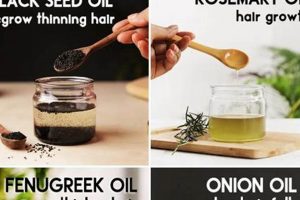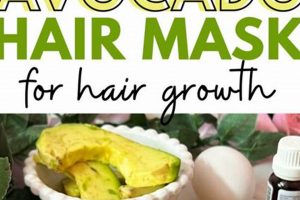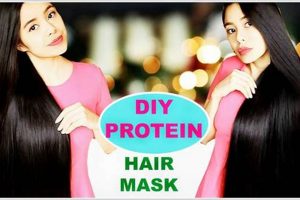A treatment formulated at home, intended to revitalize depleted and fragile hair, often incorporates common kitchen or cosmetic ingredients. These preparations aim to provide moisture, protein, or other essential nutrients directly to the hair shaft, mitigating the effects of heat styling, chemical processes, or environmental stressors. For instance, a blend of avocado, honey, and olive oil, applied to the hair and left for a designated period, serves as such a remedy.
The significance of utilizing readily available components for hair restoration lies in its accessibility, cost-effectiveness, and control over ingredients. Individuals can customize recipes to address specific hair concerns, such as dryness, breakage, or lack of shine. Historically, the practice of employing natural elements for cosmetic purposes predates commercial formulations, reflecting a long-standing tradition of harnessing nature’s properties for beauty and wellness.
The following sections will delve into specific ingredient considerations, formulation techniques, and application guidelines for creating personalized solutions to address various forms of hair debilitation.
Tips for Formulating an Effective Solution
The creation of a homemade hair restorative treatment requires careful consideration of ingredients and application methods to maximize its potential benefits.
Tip 1: Ingredient Selection: Prioritize ingredients known for their moisturizing or protein-rich properties. Avocado, rich in fatty acids, can restore hydration, while eggs provide protein to strengthen the hair shaft. Ensure ingredients are fresh and free from contaminants.
Tip 2: Formulation Consistency: Achieve a smooth, even consistency to facilitate even distribution throughout the hair. Lumps or clumps can prevent uniform coverage, reducing the treatment’s efficacy.
Tip 3: Scalp Assessment: Consider the scalp’s condition when selecting ingredients. Oily scalps may benefit from lighter oils or ingredients with clarifying properties, while dry scalps require richer, more emollient substances.
Tip 4: Strand Testing: Before applying the treatment to the entire head, perform a strand test. This helps to identify potential allergic reactions or adverse effects on hair color or texture.
Tip 5: Application Technique: Apply the treatment to clean, damp hair, focusing on the mid-lengths and ends, where damage is typically most pronounced. Avoid excessive application to the scalp unless the scalp is specifically targeted for treatment.
Tip 6: Processing Time: Adhere to the recommended processing time for each formulation. Over-processing can lead to adverse effects, such as excessive moisture or protein overload, resulting in brittle or gummy hair.
Tip 7: Rinsing and Cleansing: Thoroughly rinse the treatment from the hair with lukewarm water. Follow with a gentle shampoo and conditioner to remove any residue and restore the hair’s natural pH balance.
Tip 8: Frequency of Use: Limit the frequency of use to once or twice per week, depending on the severity of the damage and the hair’s individual needs. Overuse can disrupt the hair’s natural moisture balance.
By carefully selecting ingredients, applying the formulation correctly, and monitoring the hair’s response, individuals can effectively leverage at-home remedies to improve hair health and appearance.
The subsequent section explores frequently asked questions regarding formulation and application techniques.
1. Hydration Restoration
Hydration restoration is a foundational element in addressing compromised hair integrity through at-home treatments. Hair becomes susceptible to breakage, split ends, and a coarse texture when moisture levels are depleted. Thus, replenishing hydration is paramount to restoring hair’s suppleness and resilience. Formulating a suitable at-home treatment necessitates selecting ingredients capable of effectively delivering and retaining moisture within the hair shaft.
- Humectant Incorporation
Humectants, such as honey or glycerin, attract moisture from the environment and bind it to the hair. Including these in a formulation helps to increase the water content of the hair strand. However, their efficacy is dependent on ambient humidity levels; in arid climates, humectants may draw moisture from the hair itself, counteracting the intended benefit. Proper formulation considers this potential drawback, often pairing humectants with occlusive agents.
- Emollient Application
Emollients, including oils like coconut and olive oil, smooth the hair cuticle, reducing friction and imparting shine. These substances create a hydrophobic barrier that prevents water loss from the hair shaft, helping to maintain hydration. Their application should be judicious, as excessive use can lead to product buildup and a greasy appearance.
- Deep Conditioning Mechanisms
Deep conditioning, whether achieved through heat application or prolonged treatment duration, enhances the penetration of hydrating ingredients into the hair cortex. Heat opens the cuticle, allowing larger molecules to access the inner layers of the hair. However, heat application must be carefully monitored to prevent thermal damage.
- pH Balance Consideration
Maintaining an appropriate pH level is critical for optimal hydration. Alkaline environments cause the hair cuticle to swell, increasing porosity and moisture loss. Acidic rinses, such as diluted apple cider vinegar, can help to close the cuticle and seal in moisture. The pH level of at-home treatments should be carefully calibrated to avoid disrupting the hair’s natural pH balance.
The integration of humectants, emollients, and controlled application techniques, coupled with careful attention to pH balance, ensures that hydration restoration is effectively addressed. Consequently, the selection of appropriate ingredients and the proper application of at-home hair treatments are essential for achieving tangible improvements in hair health and appearance, specifically mitigating the effects of damage.
2. Protein Infusion
Hair’s structural integrity relies heavily on keratin, a protein. Damage, whether from heat styling, chemical treatments, or environmental factors, compromises this protein structure, leading to weakened, brittle hair prone to breakage. Protein infusion, in the context of at-home hair treatments, aims to replenish the lost or damaged protein, effectively reinforcing the hair shaft. For instance, an egg-based mask, rich in protein, can temporarily fill gaps in the hair’s cuticle, making it smoother and more resilient. However, it’s crucial to differentiate between protein need and moisture need; over-application of protein, particularly in hair that primarily needs moisture, can lead to stiffness and further breakage. Therefore, understanding hair’s condition is paramount before implementing protein-based treatments.
The selection of protein-rich ingredients for homemade remedies varies depending on the specific type of damage and hair texture. Hydrolyzed proteins, such as those derived from quinoa or rice, are often preferred due to their smaller molecular size, enabling them to penetrate the hair shaft more effectively. Gelatin, another protein source, can be dissolved in water to create a glaze that coats the hair, providing temporary strengthening and smoothing benefits. Application techniques also play a vital role; treatments are typically applied to clean, damp hair, left for a specified duration, and then thoroughly rinsed. However, the effectiveness of protein infusion is contingent on the overall formulation; a balanced approach that also incorporates moisturizing agents ensures the hair doesn’t become overly dry or brittle.
In summary, protein infusion is a critical aspect of at-home treatments for compromised hair, addressing structural deficits by replenishing lost keratin. Success hinges on accurate assessment of hair’s protein needs, selection of appropriate protein sources, and balanced formulation with moisturizing agents. Challenges lie in preventing protein overload and ensuring proper application techniques. The ultimate goal is to fortify the hair, reducing breakage and enhancing its overall health and appearance, within the framework of a well-rounded approach.
3. Cuticle Sealing
Compromised hair, characterized by a raised or damaged cuticle, is inherently susceptible to moisture loss, protein depletion, and further external damage. The cuticle, the outermost layer of the hair shaft, acts as a protective barrier. When this barrier is disrupted, the hair’s cortex is exposed, rendering it vulnerable. Cuticle sealing, as a component of at-home hair treatments for compromised hair, directly addresses this vulnerability by smoothing down the cuticle scales, thus restoring the hair’s natural protective function. This is analogous to repairing the shingles on a roof; a complete, intact roof protects the structure below, just as a sealed cuticle protects the hair’s cortex. For instance, after chemical treatments such as perming or coloring, the hair’s cuticle is often left open and porous. Utilizing an acidic rinse, such as diluted apple cider vinegar, can effectively lower the pH of the hair, causing the cuticle to close and seal, thereby preventing excessive moisture loss and maintaining color vibrancy.
The practical application of cuticle sealing extends beyond post-chemical treatment care. Daily environmental stressors, such as sun exposure and pollution, can gradually erode the cuticle. Regular incorporation of sealing agents, such as oils rich in fatty acids, into at-home restorative treatments can mitigate these effects. For example, applying a small amount of argan oil to damp hair after washing can smooth the cuticle, reducing frizz and imparting shine. Furthermore, understanding the principles of cuticle sealing enables individuals to tailor their treatments to specific hair types and concerns. Coarse hair, for instance, may benefit from heavier oils and more frequent sealing treatments, while fine hair may require lighter formulations to avoid weighing the hair down.
In summary, cuticle sealing is an indispensable element of at-home hair treatments aimed at repairing compromised hair. It directly addresses the root cause of many hair issues a damaged protective barrier by smoothing the cuticle and preventing further damage. The proper understanding and application of cuticle sealing techniques, tailored to individual hair needs and environmental factors, can significantly enhance the effectiveness of at-home restorative regimens. Challenges lie in avoiding product buildup and identifying appropriate sealing agents for different hair types. Ultimately, cuticle sealing serves as a cornerstone in the pursuit of healthier, more resilient hair.
4. Scalp Health
The condition of the scalp exerts a direct influence on hair health, thereby modulating the efficacy of any at-home hair treatment. A compromised scalp, whether due to dryness, inflammation, or imbalances in microbial flora, provides a less than optimal foundation for hair growth and repair. Therefore, any discussion of remedies for weakened hair must necessarily incorporate strategies for promoting a healthy scalp environment.
- Sebum Regulation
Sebum, the natural oil produced by the scalp, plays a critical role in maintaining hydration and protecting against microbial overgrowth. Imbalances, either excessive or deficient sebum production, can lead to scalp conditions such as seborrheic dermatitis or dry scalp, both of which impede healthy hair growth. Solutions must consider scalp-specific needs; for instance, masks containing tea tree oil may benefit scalps with excess sebum due to its antimicrobial properties, while those with dry scalps may require masks rich in emollient oils to restore hydration.
- Inflammation Mitigation
Inflammation of the scalp, often caused by irritants, allergies, or underlying skin conditions, can disrupt hair follicle function and contribute to hair thinning or loss. Ingredients such as aloe vera or chamomile, known for their anti-inflammatory properties, can be incorporated into at-home treatments to soothe and calm the scalp. Addressing inflammation not only improves scalp health but also creates a more conducive environment for hair to recover from damage.
- Exfoliation and Circulation
Gentle exfoliation of the scalp removes dead skin cells and debris, preventing clogged hair follicles and promoting healthy blood circulation. Improved circulation enhances the delivery of nutrients to the hair roots, supporting hair growth and resilience. Masks containing fine-ground oatmeal or sugar can provide mild exfoliation; however, caution is advised to avoid over-exfoliation, which can irritate the scalp and exacerbate existing conditions.
- Microbiome Balance
The scalp hosts a complex ecosystem of microorganisms, and maintaining a balanced microbiome is essential for scalp health. Disruptions in this balance, often caused by harsh shampoos or environmental factors, can lead to conditions such as dandruff. Treatments that promote a healthy microbiome, such as those containing probiotics or prebiotics, can help to restore balance and alleviate scalp irritation, indirectly supporting healthier hair growth and improving the effectiveness of restorative treatments.
The interplay between scalp health and hair condition is undeniable. By addressing imbalances and promoting a healthy scalp environment, at-home restorative treatments for compromised hair can achieve greater efficacy. Recognizing the specific needs of the scalp, whether it requires sebum regulation, inflammation mitigation, exfoliation, or microbiome balancing, is essential for formulating treatments that provide comprehensive support for both the scalp and the hair.
5. Ingredient Freshness
Ingredient freshness constitutes a critical determinant in the efficacy of a homemade remedy for compromised hair. The biochemical composition of natural components degrades over time, reducing their potency and potentially altering their intended effects. For example, an avocado employed in a hair treatment delivers optimal moisturizing and emollient properties when freshly ripened. As the avocado ages, its oils oxidize, diminishing its capacity to impart hydration and shine to the hair. Similarly, the enzymatic activity in fresh honey, known for its humectant properties, declines with prolonged storage, reducing its ability to attract and retain moisture in the hair shaft. Therefore, the utilization of recently procured or harvested ingredients ensures that the treatment delivers the full spectrum of intended benefits.
The practical significance of ingredient freshness extends beyond merely maximizing potency. Deteriorated components can, in some cases, introduce unintended or adverse effects. For instance, rancid oils can impart an unpleasant odor to the hair, while stale yogurt may harbor harmful bacteria. The inclusion of such compromised ingredients undermines the intended therapeutic effect and may potentially exacerbate existing scalp or hair conditions. Furthermore, the freshness of certain ingredients directly impacts their structural integrity within the formulation. A fresh egg, for example, provides a more cohesive and easily emulsified protein source compared to an aged egg, resulting in a smoother and more evenly distributed hair treatment.
In conclusion, ingredient freshness is not merely a desirable attribute but a fundamental requirement for formulating effective and safe at-home hair treatments. The diminished potency and potential for adverse effects associated with degraded components underscore the importance of prioritizing recently procured or harvested ingredients. The consideration of ingredient freshness aligns with the broader principle of harnessing natural resources at their peak efficacy, ensuring that the remedy delivers its intended therapeutic value without compromising hair or scalp health. Neglecting this aspect can render even the most carefully crafted formulation ineffective or, worse, detrimental.
6. Application Frequency
The regularity with which at-home treatments for compromised hair are applied directly influences their overall effectiveness and potential for adverse effects. Determining an appropriate application frequency requires a careful evaluation of hair type, damage severity, and ingredient potency. Infrequent application may fail to deliver sufficient restorative benefits, while excessive application can lead to product buildup, imbalances in moisture or protein levels, and subsequent damage.
- Hair Porosity and Treatment Absorption
Hair porosity, the hair’s ability to absorb and retain moisture, plays a significant role in determining application frequency. Highly porous hair tends to absorb treatments more readily, potentially benefiting from more frequent applications. Conversely, low-porosity hair may experience product buildup with frequent treatments, necessitating less frequent applications and lighter formulations. For example, damaged hair with high porosity may benefit from a weekly treatment to replenish lost moisture and protein, while low porosity hair may only require a bi-weekly application to avoid over-saturation.
- Protein Overload and Moisture Imbalance
Protein-rich treatments, while beneficial for strengthening damaged hair, can lead to protein overload if applied excessively. Protein overload can result in brittle, stiff hair prone to breakage. Similarly, frequent application of highly moisturizing treatments can lead to hygral fatigue, a condition where the hair cuticle stretches and weakens due to excessive water absorption and loss. Striking a balance between protein and moisture is essential, and adjusting application frequency can help prevent these imbalances. The application of at-home remedies should be measured by observable changes in the hair.
- Scalp Sensitivity and Irritation
The sensitivity of the scalp must also be considered when determining application frequency. Frequent application of certain ingredients, particularly those with strong acidic or alkaline properties, can irritate the scalp, leading to inflammation or allergic reactions. Individuals with sensitive scalps should opt for less frequent applications and milder formulations. A patch test prior to full application can help identify potential irritants. Signs of irritation following application warrant immediate cessation and adjustments to the chosen remedy.
- Treatment Composition and Ingredient Potency
The specific ingredients used in the remedy influence the optimal application frequency. Highly concentrated or potent ingredients may require less frequent application to avoid adverse effects. Conversely, treatments with milder or more diluted ingredients may be applied more frequently to achieve the desired results. Understanding the chemical properties and potential side effects of each ingredient is crucial for determining a safe and effective application schedule. Consideration should be given to the long-term accumulation of treatment components within the follicle.
In summary, establishing the appropriate application frequency for at-home hair treatments requires a holistic assessment encompassing hair porosity, potential for protein or moisture imbalances, scalp sensitivity, and treatment composition. A one-size-fits-all approach is not advisable. By carefully considering these factors and monitoring the hair’s response, individuals can optimize the benefits of at-home remedies while minimizing the risk of adverse effects. Continual monitoring and modification of application frequency is a critical element of sustained hair health.
Frequently Asked Questions
The following addresses common inquiries and misconceptions regarding the formulation and application of homemade remedies intended to restore the integrity of depleted hair.
Question 1: Are at-home treatments as effective as professional salon treatments for significantly compromised hair?
The efficacy of at-home treatments depends on the severity of the damage and the nature of the ingredients employed. Professional salon treatments often utilize higher concentrations of active ingredients and advanced application techniques not readily available for at-home use. While at-home remedies can provide noticeable improvements in hair health and appearance, they may not fully replicate the results of professional interventions for severely damaged hair.
Question 2: Can at-home treatments reverse split ends?
No at-home treatment can permanently fuse split ends back together. Split ends are a physical manifestation of hair fiber degradation and require physical removal, typically through trimming. However, at-home treatments can help to temporarily bind the split ends, making them less noticeable, and more importantly, prevent further splitting up the hair shaft. Regular application of moisturizing and protein-rich remedies can strengthen the hair and reduce the likelihood of new split ends forming.
Question 3: Is it possible to overdo at-home hair treatments?
Yes, excessive application of at-home treatments can lead to adverse effects. Over-moisturizing can result in hygral fatigue, weakening the hair, while excessive protein application can cause stiffness and breakage. The key is to strike a balance and monitor the hair’s response to the treatments. Less frequent application with careful observation yields more effective, positive results. As well, you should observe the reaction of the scalp itself during the treatment.
Question 4: How does one determine the correct proportion of ingredients in an at-home hair treatment recipe?
Adhering to established and reputable recipes is advisable, particularly when initiating at-home hair care. The ratios of ingredients such as oils, proteins, and humectants must be carefully balanced to avoid adverse effects. Over time, and with experience, one may adjust recipe parameters based upon observed effects, one element at a time. Before full applications it is always best to trial any recipe modification on only a small portion of the hair, strand-testing, so as to limit unanticipated consequences.
Question 5: Can at-home treatments damage color-treated hair?
Certain ingredients, such as lemon juice or strong acids, can alter or fade hair color. Individuals with color-treated hair should exercise caution when selecting ingredients for at-home remedies and perform a strand test before applying the treatment to the entire head. It is best to favor products which have a known track record for use with color treated hair. Ingredient lists of commercially available hair treatments may prove informative for formulation of DIY remedies.
Question 6: How should homemade remedies be stored to maintain their effectiveness?
Proper storage is crucial to preserve the integrity of homemade remedies. Refrigeration is generally recommended to slow down degradation and prevent bacterial growth. Treatments containing perishable ingredients, such as eggs or avocado, should be used promptly and discarded after a short period, typically within a few days. Airtight containers and dark environments can also help to protect the remedies from oxidation and light exposure.
In conclusion, while at-home treatments offer a cost-effective and customizable approach to hair care, informed decision-making and careful execution are essential for maximizing benefits and minimizing risks. It is always advisable to consult with a qualified trichologist or dermatologist if problems persist.
The concluding segment will summarize the key concepts discussed and provide guidance on integrating these practices into a comprehensive hair care regimen.
Conclusion
The preceding discussion has elucidated the multifaceted nature of at-home treatments for depleted hair. Key tenets include the imperative for strategic ingredient selection, precise formulation techniques, and meticulous attention to application frequency. Hydration restoration, protein infusion, cuticle sealing, and scalp health represent primary focal points. Furthermore, the significance of ingredient freshness and the potential for adverse effects underscore the need for judicious implementation.
The pursuit of hair restoration through homemade remedies necessitates a commitment to informed practices and continuous evaluation. While such treatments offer a tangible avenue for improvement, they are not a panacea. Responsible utilization, guided by an understanding of hair physiology and ingredient properties, remains paramount. The individual is encouraged to consider at-home options as a supplemental, rather than a solitary, approach to comprehensive hair care, and, if indicated, to seek professional guidance for persistent problems.







